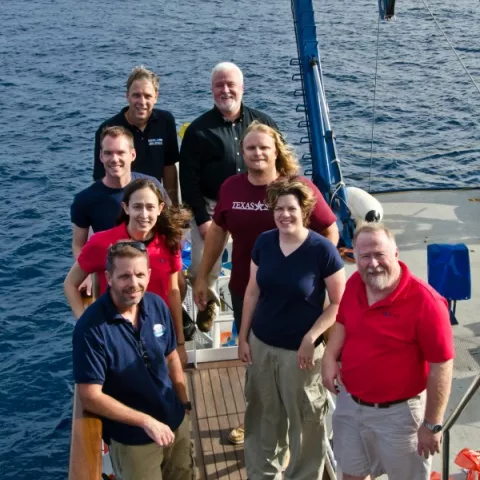July 23, 2013 -- BSEE Senior Marine Archaeologist Chris Horrell (left front) is helping a national team of scientists study Shipwreck Site 15577 in the Gulf of America. Chris checked in today with the latest information:
Q1. How many days have you been on the ship and when is the expedition over?
A1. I have been on the E/V Nautilus since Wednesday July 18th. It took us 20 hours to get on site and we have been at work 24-hours-a-day. We have five days on site and we will leave the site Wednesday, arriving back in Galveston on July 25th. I will help prepare the artifacts for transport to the conservation lab once we hit the dock. As you can tell, we work long and hard. I finally got some sleep last night after working straight for 48 hours either on watch, working on the artifacts, or helping construct boxes for the artifacts or tools to aid in the recovery of artifacts. FYI, this is the deepest archaeological excavation ever conducted in North America.
Q2. What are your responsibilities aboard the ship?
A2. I serve as a co-principal investigator along with my colleagues from Texas State University, NOAA, Texas Historical Commission and our sister bureau BOEM. My responsibilities include many things and it continues to evolve as we investigate this unique archaeological site here in the Gulf of America. One of my roles includes serving as a lead scientist guiding ROV operations as we recover artifacts from these extreme depths. I, along with my colleagues, also provide guidance regarding how we map this site with the Remotely Operated Vehicle (ROV) underwater. I have also been involved in the documentation and preparation work that is necessary once the artifacts are brought aboard E/V Nautilus. We do this to stabilize and eventually prepare for transport to the Conservation Research Laboratory at Texas A&M University. This is one of best parts of this job because I have the opportunity to handle objects that were last touched by human hands almost 200 years ago.
Q3. What have you discovered to date on the expedition?
A3. We have a phenomenal collection of artifacts/material culture that has been recovered so far. We have numerous types bottles that span the latter part of the 18th century and early part 19th century. These include beer bottles, wine bottles, champagne bottles, case bottles, and medicinal bottles. The medicinal bottles are awesome because they still contain the contents that were packed into them prior to this vessel making its final voyage. We think that the contents may be Ginger; a common cure for sea sickness during the 18th and 19h century. We also have a mix of British creamwares as well as what appear to be Latin American Ceramics or Majolicas that are hand painted. Other artifacts include utilitarian wares from the Yucatan region of present day Mexico called Cantaros; these likely contained some liquid such as drinking water. We have other personal items such as an Octant which was used for navigation. We are planning to recover a number of things today including muskets, sword, a spyglass, a gudgeon (part of a ship's rudder assembly), wood samples, copper samples, core samples, and a woolen jacket with buttons. We are super excited about the work we are doing today and can't wait to see what we learn.
Q4. What is left to do?
A4. Unfortunately, all projects have to come to an end and we are rapidly approaching the end of this project. When we started the project, we created a photo mosaic of the site with the ROV; something we must complete prior to conducting any bottom-disturbing activities at this site. Once we finish up our collection of artifacts we will make a final mosaic of the site to document what has been recovered and what changes we have caused to the site. This is part of the transparency of conducting an archaeological investigation at any site. As archaeologists, we are responsible for fully documenting all of our activities so that future researchers have the opportunity study and learn from this incredible site.
Q5. What will be the next steps once the expedition is over?
A5. All artifacts will be conserved at the Conservation Research Laboratory at Texas A&M University. Once that is complete, the entire assemblage will be sent to the Center for Archaeological Studies at Texas State University for curation. From there, the assemblage will go on loan to various museums.
Q6. Have you been able the age and history of this ship?
A6. Well, that is an excellent question! Currently we feel strongly that this site may be date from the late 18th century (~1790) to around the early portion of the 19th century (~1820).
Q7. How will BSEE use the information obtained during this expedition?
A7. This research will enable the BSEE Environmental Enforcement Division (EED), specifically BSEE's historic preservation program, the opportunity to understand important issues related to archaeological sites at extreme depths. This includes what a debris field looks like from a wooden shipwreck site. This is important because it will enable BSEE to provide accurate and reasonable guidance to the oil and gas industry as they propose and prepare to conduct their bottom-disturbing activities in the vicinity of archaeological sites. Additionally, studies such as this provide BSEE information on appropriate avoidance criteria for the oil and gas industry.
In addition, a study such as this (i.e. investigating a pristine undisturbed archaeological site such as this) gives BSEE's Seafloor Compliance and Monitoring Program (SCAMP) the opportunity to hone our abilities in extreme depths, which BSEE must do to enforce the government's requirements not to disturb historical sites. Finally, BSEE's Historic Preservation Program will use this information to educate the public about our nation's non-renewable cultural and historic submerged maritime heritage; especially the Gulf of America's fascinating maritime heritage.

